Great Profile on the Ann Arbor Comics Scene
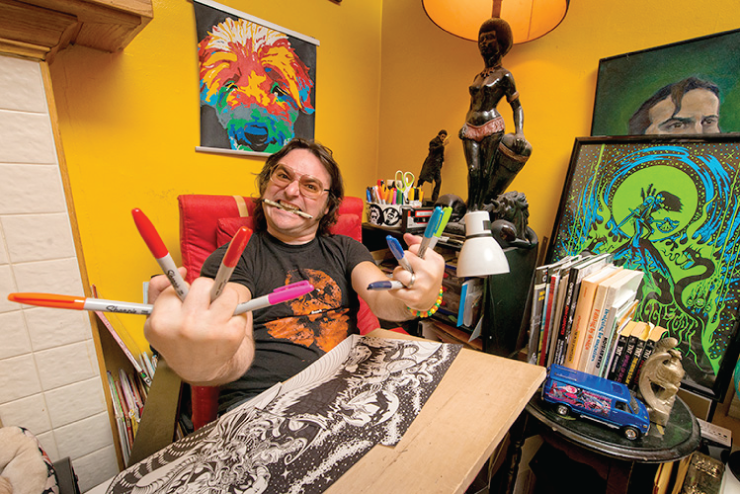
Natalie Burg had an excellent piece in Concentrate earlier this month about the Ann Arbor comics scene.
From the article:
"With so much local talent making waves from the internet to Hollywood, Ann Arbor's comics and graphic novels scene—no matter how well connected the artists are with one another—is having a big impact on comics fans, both locally and around the world."
Many of the artists who appear in the article are represented in the AADL catalog, including:
- Katie Cook
- Jerzy Drozd
- Jim Ottaviani
- Pete Sickman-Garner
- Bruce Worden
AADL has been happy to work with some of the artists on projects like making Ottaviani's titles available in our Downloads collection, or Drozd's Nerd Nite talk on 1980s cartoons or his Comics Are Great! video podcast series.
So check out the article, and discover a new appreciation for your local comics artists!
Review: Come As You Are

I’ve been waiting a few years now for the day that the 1990s are far enough behind us that we can start to look at that decade and the art that came out of it with a more objective eye, and the Come As You Are installation at UMMA seems to imply that perhaps that day is finally here!
The best thing about the installation, located in a large exhibit space on the second floor of the museum, is the diversity of mediums that comprise it. Paintings, sculptures, film, photographs, and large-scale multimedia installations are all represented. And, despite the bright colors, sounds, and even quick movement (!) of some of the pieces, they all come together to create an unusual sense of peace in the room… with a distinctive ‘90s aura.
Upon entering, viewers are directed to turn to their left (although I am sure many will be distracted, as I was, by a piece to the right featuring an office chair spinning at seemingly impossible speeds). The decade is broken into three segments for purposes of organization of the installation, beginning with 1989-1993, a time when the United States was rampant with debates about multiculturalism, race, and the “American identity,” and when issues of gay rights and feminism were just beginning to be truly discussed in the public sphere. As the introduction to the exhibit points out, it was dramatic political and social events that pushed these issues to the forefront of the media in the early 1990s: the Clarence Thomas Supreme Court decision, the Los Angeles race riots and Rodney King beating, and the continued AIDS crisis. The art pieces from these years reflect these issues well. "Synecdoche", by artist Byron Kim, is a grid of monochrome painted panels that doesn’t necessarily catch the eye at first. I was fascinated to read, however, that each panel represents exactly—or at least as close as Kim could get to—the skin tone of an individual that Kim invited to “sit” for a portrait. With “synecdoche” referring to a part that stands for a whole, Kim’s piece makes a simple, yet interesting commentary on a racially diverse society.
Prior to this, however, is a case of Rolling Rock bottles enclosed in bright orange plexiglass—a remnant from one of the performative installations of 1991 by the artist Rirkrit Tiravanija, who invited people to sit and share drinks and a meal together while discussing issues of the day. Other moving pieces from the early 1990s include a velvet couch embroidered with the words of a suicide note left by a single immigrant mother to her daughter, and two enormous dresses with unnaturally long arms—a piece entitled "Famous Twins", by Beverly Semmes, that comments on skewed perceptions of the female body image. I didn’t quite “get” "Lick and Lather", by Janine Antoni, which features two self-portrait busts of the artist, one of soap and one of chocolate, but was absolutely fascinated—and somewhat horrified—to find out that Antoni formed them by licking away the chocolate and lathering away the soap.

The mid-1990s mark the advent of the digital age, and the art in this portion of Come As You Are does, too. Digital photographs and several short films make up most of the art in this section. For one of the films, viewers actually step behind a dark velvet curtain for an enclosed viewing experience, a sharp contrast from wandering through the bright white rooms that house the rest of the pieces.
In the late 1990s, the focus of the art divides somewhat. About half of the pieces make statements on American cultural stereotypes in the latter portion of the decade, while others turn outward and focus on globalization and America’s role in the global economy. Nikki S. Lee has a series of self-portrait photographs on display, in which she portrays women who “typify” late-1990s American culture: a punk rocker, a Latina woman on a sunny city street, and a woman in an Ohio trailer near a confederate flag enacting a “white trash” stereotype. Nearby, Jeanne Dunning brilliantly contrasts a close-up photograph of a skinned tomato with an adjacent photograph of a mischievously-smiling woman, tomato juice running out of her mouth, inviting viewers to contemplate how women are often portrayed sexually in art—and that when a piece of art portrays a woman, it’s difficult to not see sexual undertones, even when none are intended.
Concluding the room are two vastly different pieces: the first simply a television screen with a screenshot of an actual Ebay auction from 2001: that of “Keith Obadike’s Blackness,” which will allow the purchaser to “gain access to ‘high risk’ neighborhoods” and acquire the ability of “instilling fear.” The second and final piece is a large, room-sized multimedia installation entitled "Department of Marine Animal Identification of the City of San Francisco (Chinatown Division)". Artist Mark Dion and his team actually researched and identified both the biological and geographical origins of the fish sold on a given day in San Francisco’s Chinatown in 1997, a perfect sort of microcosm of the global economy. The art installation looks like a laboratory, with fish samples, files, and notes scattered about. This is the first time the piece has been exhibited since the year it was created.
I might be a little biased because I’m fascinated by the political and social events and the unique culture of the 1990s, but I found Come As You Are to be a particularly interesting, thoughtful, and special exhibition of art. As the first major museum installation showcasing the art of the decade, it really is a must see—even for those who remember the ‘90s less fondly than I do.
Elizabeth Pearce is a Library Technician at the Ann Arbor District Library.
University of Michigan Museum of Art: Come As You Are will run through January 31, 2016. The UMMA is located at 525 S. State Street. The Museum is open Tuesday-Saturday 11 am-5 pm; and Sunday 12-5 pm For information, call 734-764-0395.
I'm Dreaming of a Stockingful of Holiday Stuff
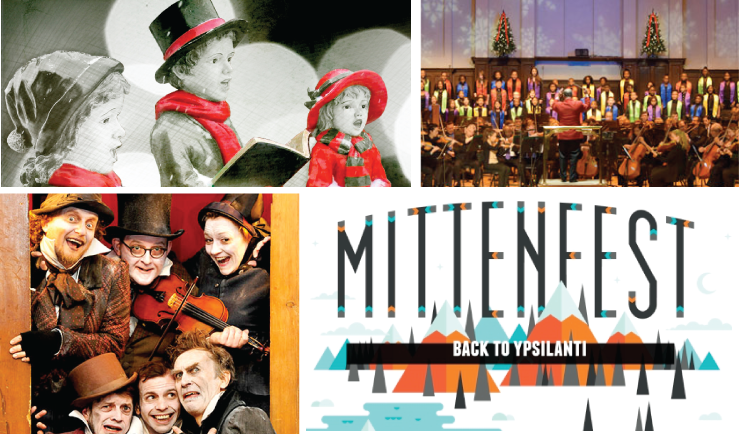
December is upon us and, like the giant rolling boulder in that one Indiana Jones movie, the holidays are rumbling ever closer.
If you need some tips to help you celebrate the season, here's a handy list of festive holiday things going on in the area:
Dickens: An A Capella Carol
Friday, November 27th - Sunday, December 20th
Performance Network Theater - Ann Arbor, MI
National Theatre of Scotland: A Christmas Carol
Thursday, December 17th - Sunday, January 3rd
Power Center for Performing Arts - Ann Arbor, MI
Ypsilanti Community Choir's Annual Holiday Concert
Thursday, December 17th
Washtenaw Community College - Ann Arbor, MI
Gifts of Art presents Holiday Harmonies with Counterpoint
Thursday, December 17th
University Hospitals - Ann Arbor, MI
Home for the Holidays! with the Detroit Symphony Orchestra
Friday, December 18th - Sunday, December 20th
Detroit Symphony Orchestra - Detroit, MI
The Corner Christmas! (Not Your Family's Christmas Party) at the Corner Brewery
Saturday, December 19th
Arbor Brewing Company Microbrewery - Ypsilanti, MI
Krampus Costume Ball
Saturday, December 19th
The Dreamland Theater - Ypsilanti, MI
Scones and Shopping at the Eyrie
Saturday, December 19th
The Eyrie - Ypsilanti, MI
X'mas Explosion 4 feat. Archimime, Meridians, Scapegoat and The Path Of Exile
Saturday, December 19th
The Maidstone Theater - Ypsilanti, MI
Museum of Natural History Planetarium: Season of Light
December 19th-20th, 27-30th
University of Michigan Museum of Natural History - Ann Arbor, MI
Winter Solstice Celebration
Tuesday, December 22nd
Cultivate Coffee and Taphouse - Ypsilanti, MI
Gifts of Art presents Sweet Sounds of the Season with Wanda Degen
Thursday, December 24th
University Hospitals - Ann Arbor, MI
Black Christmas Feat. The Suicide Machines, The Black Dahlia Murder, BIGWIG, Mustard Plug, Koffin Kats
Saturday, December 26th
The Majestic - Detroit, MI
Mittenfest X
Tuesday, December 29th - Saturday, January 2nd
Bona Sera Cafe - Ypsilanti, MI
Nicole Williams is a Production Librarian at the Ann Arbor District Library and she's been listening to Christmas music since July.
We're Dreaming of a Handmade Christmas
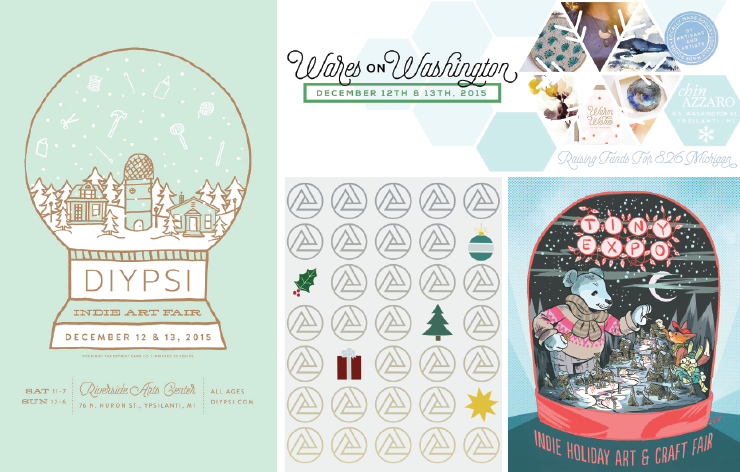
It's that time of year when it seems like there's a cool craft fair to attend every weekend. It’s especially going to seem that way during the weekend of December 12-13, when no fewer than four events will be hopping with handmade shopping in both Ann Arbor and Ypsilanti.
Saturday, December 12 marks the sixth annual Tiny Expo Indie Holiday Art & Craft Fair. The fair will be held at the Downtown location of the Ann Arbor District Library again this year. This is the second year that the show will be hosted at AADL, after bouncing around to different locations in its early years, and Tiny Expo is now happy to call AADL home.
The juried craft fair has grown a bit: this year it will feature 45 artists and crafters offering handmade wonders of all kinds. The event will also include a kid-friendly snow globe making workshop, a letterpress demo, and AADL’s new Secret Lab will be open and unveiling secrets.
Just down the road in Ypsilanti, the DIYpsi Holiday Market will take place on December 12-13 at the Riverside Arts Center. DIYpsi will feature 80 artists, and in addition will offer artisan food and beverages for sale. This is also the 6th year for the DIYpsi Holiday Market, which came into being after Ypsilanti’s Shadow Art Fair decided to no longer host a holiday fair.
A group of artists in Ann Arbor and Ypsilanti independently desired to fill the gap and offer an opportunity for artists to sell their work and for shoppers to buy local and handmade. From this came Tiny Expo and DIYpsi and a MEGA craft fair weekend! Many shoppers make a weekend of it and hit up both fairs to browse an assortment of unique, quality handmade goods and have a good time.
To make the weekend even merrier, there are a few more events happening in Ypsilanti both Saturday and Sunday, just a hop, skip, and a jump from DIYpsi. Wares on Washington is in pop-up store format and is a community fundraiser for 826Michigan.
There is also Ypsi Alloy Studios, hosting their first annual Open Studio & Holiday Market. Visitors can check out the studio space where visual artists can make, create, and collaborate. The market will feature fine art and handmade gifts by a small group of artists, as well as a cash bar and a gift wrapping station.
More and more indie craft fairs pop up across Michigan each year, giving shoppers opportunities to shop local and buy handmade. It’s a great way to support local artists, keep the cash in our local economy, and have a unique, fun shopping experience outside the big box stores. And let’s face it, craft fairs usually have a better soundtrack and tastier drinks.
So if you’re looking for the coziest scarf ever, soap that smells like raspberry s’mores, a uterus-shaped brooch, a necklace made from graffiti found in Ann Arbor and Detroit, a piece of art to frame, or your new favorite ceramic mug, these creativity-filled craft fairs have you covered.
Amanda Schott is a Library Technician at AADL and readily admits to her craft fair addiction.
Tiny Expo takes place at the Downtown Ann Arbor District Library Saturday, December 12 from 11 am-5:30 pm. Free admission.
DIYpsi takes place at the Riverside Arts Center Saturday December 12 from 11 am-7 pm and Sunday, December 13 from Noon-6 pm. Admission is $1.
Wares on Washington takes place at Chin-Azzaro Studio Saturday December 12 from 10 am-6 pm and Sunday, December 13 from 11 am-4 pm. Free admission.
Ypsi Alloy Studios Open Studio & Holiday Market takes place at Ypsi Alloy Studios Saturday December 12 and Sunday December 13 from Noon-6 pm both days. Free admission.
Preview: The Seventh Westside Neighborhood Art Hop

It's Art Hop time! Artists on Ann Arbor's Westside are opening their homes and studios to the public this Saturday, for viewing and sale of art and craft items. It's your chance to find that one-of-a-kind gift (and to enjoy the sun before Jack Frost comes to stay). Past Art Hops have featured everything from paintings and photography to 3D art–ceramics, wood sculptures, and blown glass. Items range in price from $3.50 to $350.00. Live music at some venues.
Anne Drozd is a Production Librarian at the Ann Arbor District Library.
The Westside Neighborhood Art Hop is 11 am to 5 pm Saturday, December 5, 2015 in the neighborhood bordered by Liberty Street, 7th Street, Pauline, and Eberwhite Woods in Ann Arbor. The full list of artists is available on the Westside Art Hop site. More info is on their facebook page.
In Which Bruce Eric Kaplan Talks About his Memoir and Career, But Would be Equally Happy to Discuss 1970s TV Show Plots Instead
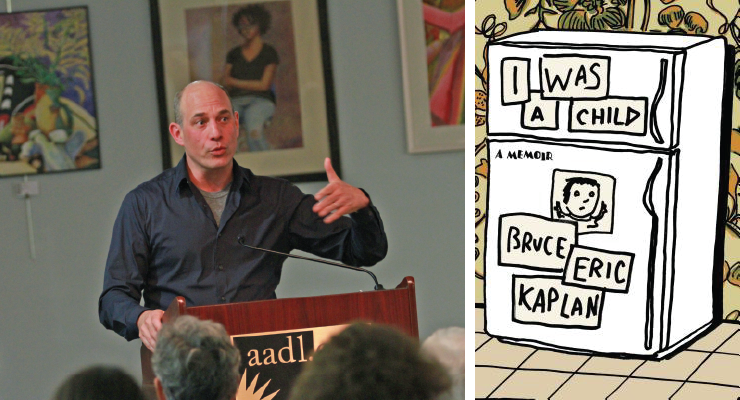
Bruce Eric Kaplan’s talk at AADL on Wednesday, November 11, could have been titled “How I Accidentally Sold a Publisher a Book About my Childhood” or “I Love TV.” But his talk really didn’t have or need a title, in keeping with his low-key, off-the-cuff, c’mon-let’s-just-keep-it-casual approach to the event. This left lots of room for audience questions and comments, resulting in an easy, back-and-forth conversation between the room and Kaplan, whose pithy single-panel cartoons have appeared in the New Yorker for 20+ years, and whose television work has included scripts for Seinfeld and Six Feet Under and a producer role with the HBO show Girls.
Kaplan came to Ann Arbor as part of the 28th Annual Ann Arbor Jewish Book Festival and he offered a short reading from his latest book, an illustrated memoir called I Was A Child. Kaplan's mother passed away several years ago, and then a couple of months after his father passed on as well, Kaplan found himself in a pitch meeting with a publisher, talking on and on about his parents and growing up in New Jersey. Afterward, he was so surprised to learn that the publisher wanted to buy this story, he made his agent call back to double check.
Kaplan says that working on this memoir was like spending day after day with his parents when they were young and healthy, and closing up his work each afternoon felt like losing them all over again. “We need a word for something that is both healthy and unhealthy for us,” he said, explaining that spending so much time thinking about his parents might have been unhealthy for him, but in the end, the closure he got from the process, was very positive. The process of writing the book also made him rethink parenting his own children, ages 8 and 10. “I realized they’re watching me,” he said.
The topic that really lit up the room, however, was television. Kaplan grew up watching TV, McMillan and Wife, I Dream of Jeannie, Lost in Space, Star Trek, Perry Mason, and countless old and semi-forgotten movies. (June Bride, anyone?) Even memories formed later in life are informed by his early love of television. For instance, after moving to Los Angeles as an adult, hoping to work in TV, he saw Mary Tyler Moore performing a scene on a soundstage. This was the breakthrough moment when Kaplan realized he could write television scripts, but in recounting it, he lovingly detailed watching The Mary Tyler Moore Show as a kid, when it was on in syndication, airing from 4-5 pm, EST, on Channel 4.
It was while writing spec script after spec script (he always thought he had a good Golden Girls episode in him, but he never managed to sell one), that he began submitting single panel cartoons to The New Yorker. At the time, artists could submit 10 ideas per week with a self-addressed, stamped envelope. He sent them in for years, his enclosed cover letters getting terser and terser, until finally, they bought one. He continues to submit cartoons monthly, and has been a regular contributor for more than 20 years. For people curious about the “labor of love” that is single-panel cartooning, Kaplan recommended an documentary, forthcoming from HBO, on New Yorker cartoonists called Very Semi-Serious.
Kaplan eventually sold several scripts to Seinfeld, which was the show that taught him that “you could incorporate your own existence into the half hour world.” In keeping with that lesson, he wrote the episode where George Costanza runs over some pigeons, an occurrence borrowed straight from the life of Bruce Eric Kaplan.
His experience working on Six Feet Under was a little different - while he wasn’t borrowing instances directly from his own life, he still felt an immediate connection to the characters on the show. “I read the pilot and I felt like I understood the family that doesn't talk and wants to connect but can't connect,” he said.
Because Kaplan was such a casual and conversational speaker, the event didn’t feel like a traditional lecture or a literary reading. It felt much more like sitting in someone’s living room, and chatting with a fellow guest who’s telling good stories about their interesting career. Then you remember you’re at AADL listening to the guy who drew this cartoon:
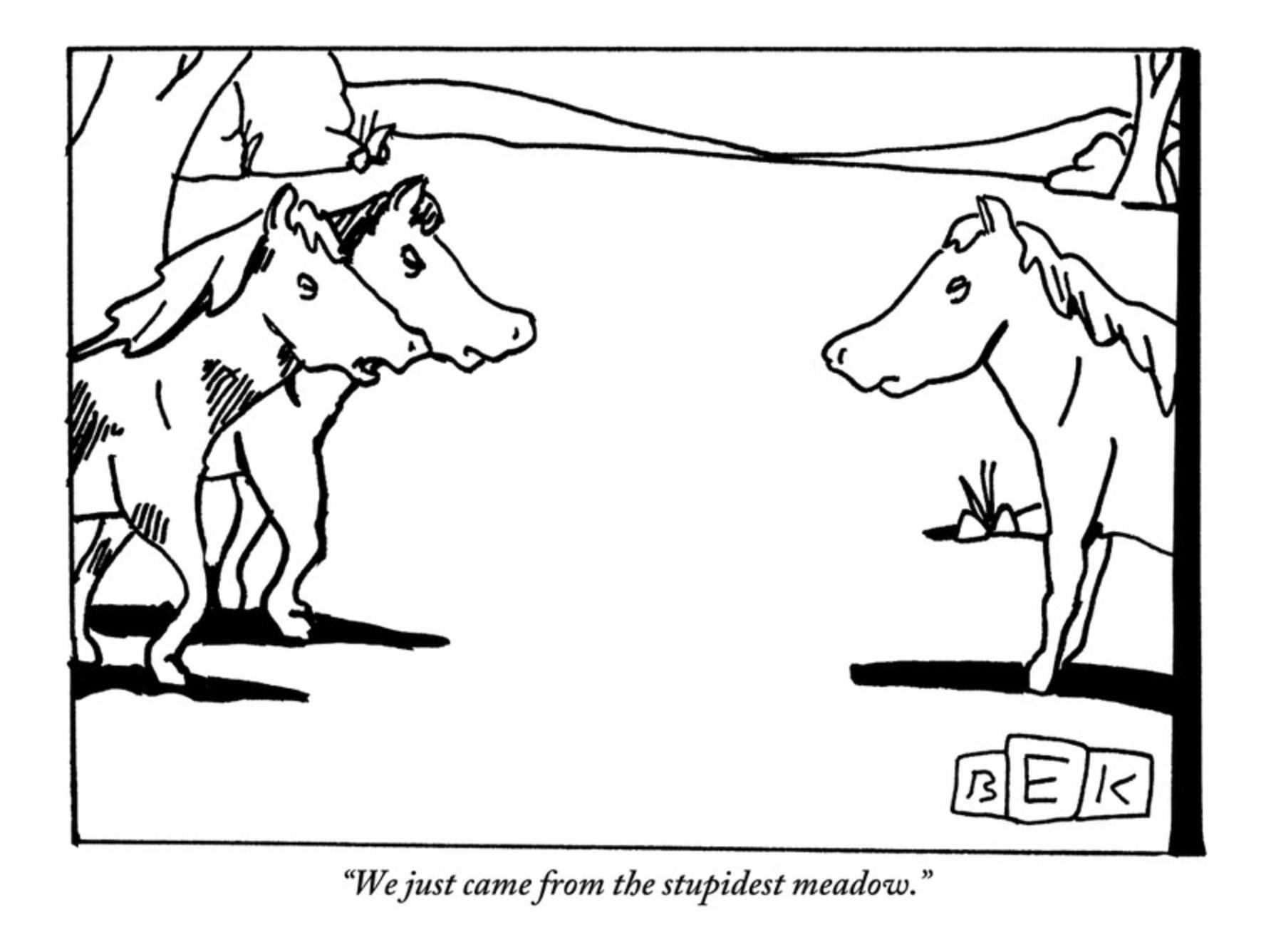
and you think, I’m really glad I came tonight.
Sara Wedell is a Production Librarian at the Ann Arbor District Library and was a real I Dream of Jeannie fan herself, back in the day.
Review: WSG gallery presents: Lynda Cole with North
![North 36h x 48w x 2d [beeswax, resin, pigment] / Image courtesy of Lynda Cole, through the WSG Gallery](/files/images/pulp/north_lynda_cole_wsg.jpg)
In Lynda Cole’s hands, North is not only a primer in the emotional power of abstract art—it’s ultimately as much a state of mind.
Granted by this local artist’s definition, “north” is a psychological place, but when seen at downtown Ann Arbor’s WSG Gallery, North is as much a time as it is a place. And it’s in this fusing of time and space—both melding a particular state of mind—where “north” resides.
“My future travel will have to have ice in it,” Cole says in her gallery statement. “Where ice is found I encounter stillness, a beautiful quality of light, large horizons of the sea and sky and the color and purity of the ice. These things contribute to a feeling of tranquility I don’t find in most other places.
“On a recent trip to the Arctic during the midnight sun,” continues Cole, “early one particular morning, I looked out over the Arctic Ocean and felt as if I was Alice falling down the rabbit hole. The sea was entirely still with bits of ice in it.
“The light quality of the sky was a pale palette, striped and moody. It felt unlike Earth.”
This moodiness is reasonable as what Cole seems to mean is that “north” is as much an expressive place as it is physical location. But as a depiction of emotion, it might not also be much of a stretch to say it’s rather a way of life: A durable outlook that’s as much equal part exaltation as it is seclusion.
Solitude gets short shrift today. The pace of contemporary life so often hurries our sense of self, the mere act of checking one’s perception of the environment can seem more of a burden than did the leisurely appreciation of the sublime in prior eras not so long ago. And although the exhibit is much more; if nothing else, North encourages a leisurely appreciation of the sublime.
“The paintings in this exhibition are painted with beeswax, Damar resin and dry colored pigments on various substrates,” says Cole of her work’s technical expertise. “Many layers of wax are painted on the substrate and heated with a torch to fuse them to layers below. It’s an ancient technique which has enjoyed a certain revival during the past 50 years or so.”
A certain revival, indeed—fusing her layers of wax with heat to bond her working surface to a high gloss luminosity, Cole’s wax is sculpted and combined with collage material to create swaths of incandescent facture whose flaring textures reflect a subdued solemnity. But it’s also a solemnity with purpose.
The title work illustrates the stunning effect Cole can craft with her materials. “North”—36” x 48” with an impressive two-inch depth—is a meticulous masterwork whose frosty pigments compete with beeswax to create a moody visage of abstracted ice and air. The work’s upper and lower irregular grids flank, yet do not quite contain, a center of competing blue fields whose incandescent depth pull the viewer’s eyes into the composition more by suggestion than articulation.
Not quite improvisation, for Cole’s command of her materials is far too controlled for this laxity, yet loosely enough crafted to allow for nonrepresentational inventiveness, “North” instead reflects an emotional timbre whose resonance strikes a firm expressive state. What’s outwardly rigid in its appearance is also nuanced in its form. For “North” is a kind of painting that requires a contemplative deliberation and willingness to explore the infinity of its surface.
It’s also a call for a thoughtful appreciation of our environs—here and elsewhere.
One of six other such considered paintings on display, North like the rest of Cole’s latest offerings at WSG follows in the unhurried continuum of her art. Her work is a reminder that art nature (like nature) often unfolds meditatively in its own time and in its own manner. We must merely follow in the imaginative manner of our forebears to appreciate splendor on its own terms.
John Carlos Cantú has written extensively on our community's visual arts in a number of different periodicals.
North will run at the WSG Gallery, 306 S. Main Street, through December 6, 2015. The WSG Gallery is open Tuesday-Wednesday, noon–6 pm; Thursday, noon-9 pm; Friday-Saturday, noon-10 pm; and Sunday 12-5 pm. For information, call 734-761-2287.
Preview-Julian Schnabel in Dialogue with Peter Brant

Julian Schnabel, painter and filmmaker, will take the stage at the Michigan Theater this Thursday evening as part of the Penny Stamps Speaker Series. Originally scheduled to kick off the Fall 2015 season in September, Schnabel’s appearance was rescheduled due to unforeseen circumstances.
Schnabel’s paintings were on display at the University of Michigan Museum of Art from July 5–September 27 of this year. In case you missed it, they were huge. His paintings are made up of unexpected materials–including broken dinner plates and Bondo putty (yes, the automotive body filler)–and took up two galleries, engulfing the walls from floor to ceiling. He is a well-known figure in the Neo-expressionism art movement, but he may be better known for his films. Schnabel wrote and directed the films Basquiat, a biopic on the painter Jean-Michel Basquiat (1996), and Before Night Falls (2000), an adaptation of Reinaldo Arenas' autobiographical novel. He also directed The Diving Bell and the Butterfly (2007) and Miral (2010).
The Patricia Urquiola talk originally scheduled for November 5 will take place as part of the Winter 2016 Penny Stamps Speaker Series, to be announced later this month. The Penny Stamps Speaker Series brings innovators from a broad spectrum of fields to Ann Arbor to conduct a public lecture and engage with students, faculty, and the larger University and Ann Arbor communities, and they are a great way to spend a Thursday evening.
Anne Drozd is a Production Librarian at the Ann Arbor District Library and once owned a car that was 57% Bondo.
Julian Schnabel's appearance is Thursday, November 5, 2015. The Penny Stamps Speaker Series takes place Thursdays at 5:10 pm at the Michigan Theater, located at 603 E. Liberty Street in downtown Ann Arbor, and all events are free of charge and open to the public. The entire lineup can be seen at the Penny Stamps site.
Canoe Imagine ART?!
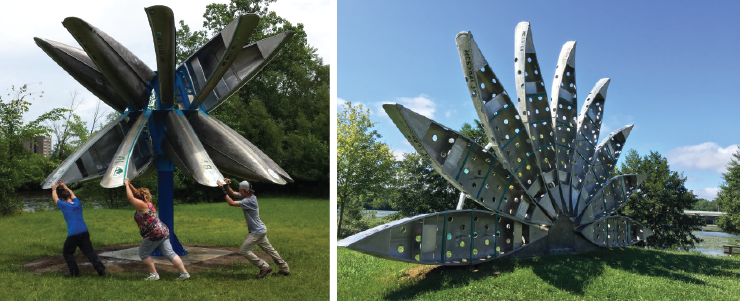
Fall is fully upon us with the falling leaves, colder temps, and strong winds, but it's still a fantastic time of year to be outside and soak up everything that Ann Arbor's parks have to offer! There are now sculptures located in four of Ann Arbor's parks: Broadway Park, Gallup Park, Island Park, and Bandemeer Park. Canoe Imagine Art (CIA), which debuted in August, is a unique partnership created by The Arts Alliance, in cooperation with the City of Ann Arbor (the City) and the Ann Arbor Public Art Commission (AAPAC). CIA repurposes retired canoes and celebrates everything about the Huron River and the City's extraordinary park system. Four works of art were selected through a juried and public vote process.
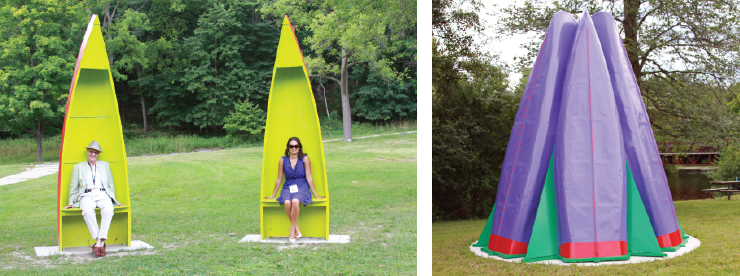
The "Turbine" sculpture in Broadway Park is a kinetic piece that uses the canoes to create a visual wheel that spins and was inspired by the movement and occasional turbulence of the river. Gallup Park has a "Canoe Fan" that evokes the feeling of a rising sun. This piece really showcases the shape of the canoe and heightens it to a different beautiful form. Island Park is home to "Canoe-vue", turning two canoes cut in half into a functional place to sit - sitting in art to observe the art of nature. Lastly, Bandemeer Park is home to "Tulip" - 10 canoes standing vertically and meeting at one point in the middle. This piece celebrates the shape of the canoe while emulating a shape found in nature.
Before the rains turn to ice and the snow we're all hoping doesn't come (fingers crossed, El Nino!) covers the canoes get out there and explore the natural and sustainable art!
Erin Helmrich is a Production Librarian at the Ann Arbor District Library - when it comes to water she prefers kayaks.
POP•X Overview

POP•X is real art in real time. And it’s an idea that’s been long overdue as Ann Arbor’s been inching its way towards this sort of event for some time now. After all, in the sphere of local music, Water Hill’s now established spring music festival has shown us how this sort of spirited activity can be handled on what is a seemingly near ad hoc basis. In this instance, POP•X is telling us in quite vivid terms: Create and they will come. During a recent midday visit at the start of the event, I saw Ann Arborites of all ages, all incomes, and all backgrounds; all crafting, browsing, and participating in what would have seemed an unlikely set of circumstances just days before.
Using Liberty Plaza as its base, POP•X effectively has melded a cluster of arts activities that have been percolating historically. But it’s also done so with a bit of Tree Town spirit.
For one of the most dispiriting effects of the 20th century visual arts has been the progressive commodification of aesthetics. Read any report about art anywhere and there’s either a subtle (or often not so subtle) reference to the monetization of the visual arts. It’s no secret that big art can wheel about untold millions of dollars with the stroke of a pen or the slam of an auctioneer’s gavel and it’s very often seemed as though this is meant to be the end product of the artistic activity.
As a result, this reification of art’s value has put a price tag on all artful activity with a grimness that squeezes joy out of the market. Art can be big business and engaging in art can be to participate in big business. It is not accidental that someone with as clever a sense of humor as Andy Warhol decided in his time to reflect this ultimately simple-minded commodification.
Well, to use a telling cliché, POP•X puts paid to this notion. Like Water Hill Music Festival—and unlike the now merchandizing effort of each summer’s local art fairs—this event is a free-for-all of artistic opportunity. Granted, it took a consortium of like-minded individuals at all levels of the regional arts market to gather themselves towards this end. And it ultimately took the nuanced and steely courage of professionals and visionaries like Omari Rush and Lucie Nisson to organize the event as well as seek and/or provide the funding. But the synergy once released has taken on a community-tinge that’s unmistakably organic.
For example, the very nature of the buildings crafted to house the individual projects in POP•X is unmistakably, and deliberately, unrefined. And the repurposing of these structures after the event ends calls into mind this very orientation: Waste not, want not.

But even more astute is the nature of the project itself.
POP•X isn’t an under-conceptualized happenstance; rather, the very nature of the project follows a clearly delineated path of artful logic in modern and post-modern art that’s been percolating for decades now. The event mirrors two of the more outrageous innovations of mid-20th century Neo-Dada—the notions of the Happening and Environmental Art.
The Happening, a sort of odd participatory aesthetic has always been subversive in its insistence on the involved hands-on element of creativity. Rather than surrender to the notion that art must be respectful (in other words, passively sitting on a gallery wall or be passed around dollar for dollar), the accomplices of this art form yield to the collective experience of the event. A sort of late-blooming offshoot of Dada, the Happening sought to push the boundaries of art in much the same way that Luigi Pirandello and Bertholt Brecht sought to push the boundaries of theatrics: Participating in the event is the art form.
Likewise, another 1960s offshoot of Neo-Dada, Environmental Art, also sought to widen the physicality of art itself—and hence, the expansive nature of art. As POP•X happily shows us, the very creation of this environment lays a foundation upon which everything else rests. As such, in some of the units, professional artists have invited the public to participate in the creation of the art activity itself, while other groups or individuals have mounted installations through which we can participate.
The end result is a heady optimism that’s infectious and it’s this invigorating cheerfulness that most succinctly describes the atmosphere of this event. And like all environmental give and takes, what one encounters will be dictated by those who are there at the same time. It’s therefore going to be useful to visit the installation site occasionally—and certainly at differing times—to absorb the varied populations that inhabit this artistic fishbowl.
Just don’t expect POP•X to conform to the tried and (supposedly) true formula of the contemporary visual arts. For its multidimensional psychological and physical bearings embroider the varied elements of the contemporary arts. There’s going to be a bit something different here for everyone.
Little surprise then that yet one final cliché fits the parameters of POP•X.
Perhaps for the first time in a long time, our local proponents of the visual arts have banded together to acknowledge a fact about art that a city the size of Ann Arbor has seemingly been built to express: It’s taken a village to express Ann Arbor’s attitude about contemporary art.
Here’s hoping this remarkable achievement is but the first of many such activities that will take place in our future.
John Carlos Cantú has written extensively on our community's visual arts in a number of different periodicals.
POP•X is an annual ten-day festival presented by the Ann Arbor Art Center. POP•X 2015 was Thursday, October 15 – Saturday, October 24, 2015 from 10 am to 8 pm at Liberty Plaza Park, 255 East Liberty St, Ann Arbor. To learn more visit popxannarbor.com or the POP•X Facebook event page. POP•X is free and open to the public.


































